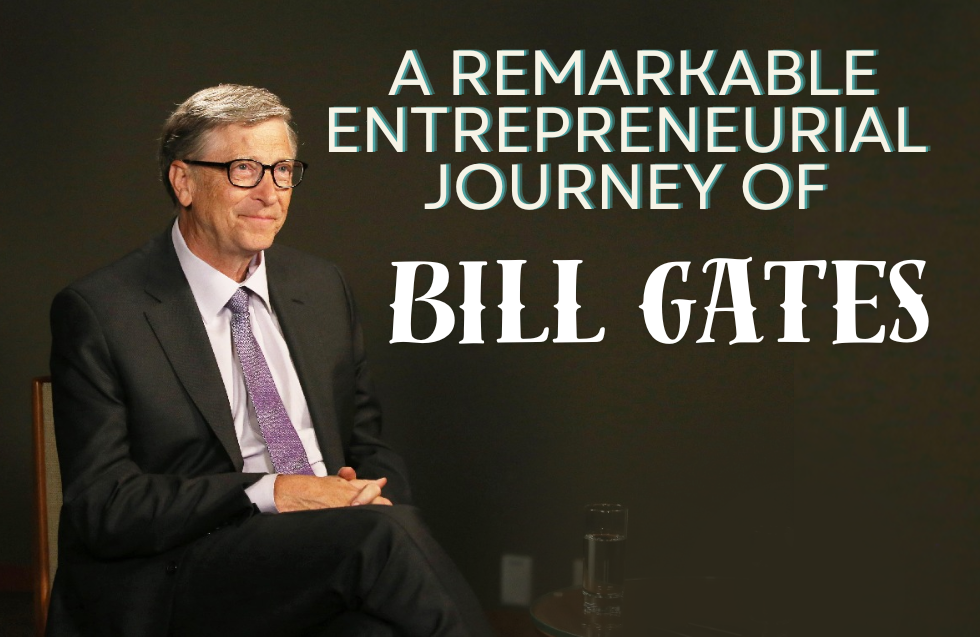The Journey of Bill Gates, a name synonymous with innovation and success, has left an indelible mark on the world of technology and business. As the co-founder of Microsoft and one of the richest people on the planet, Gates’ entrepreneurial journey offers a masterclass in vision, resilience, and philanthropy. His career is a testament to how passion for technology and a clear business vision can lead to world-changing success.
Early Life and Passion for Computers
The Journey of Bill Gates was born on October 28, 1955, into a family that valued education and intellect. His father, William H. Gates Sr., was a prominent lawyer, while his mother, Mary Maxwell Gates, served on several corporate boards. From a young age, Gates exhibited a natural curiosity and a competitive streak, excelling in academics, particularly in math and science.
Gates’ entrepreneurial traits began to show in his teenage years. At the age of 13, while attending Lakeside School, Gates and his classmates were introduced to a General Electric computer. It was here that Gates found his passion for programming, spending hours creating software for fun. This early exposure was pivotal in shaping Gates’ future.
One of Gates’ first ventures came when he and Paul Allen formed a small company called “Traf-O-Data,” which analyzed traffic data. Although this venture was not particularly successful, it gave Gates and Allen valuable experience in software development and running a business. Their collaboration and shared enthusiasm for computing would eventually lead to Microsoft.
The Birth of Microsoft
In 1975, Journey of Bill Gates made one of the boldest decisions of his life—dropping out of Harvard University to pursue his passion for software development. Along with Paul Allen, Gates co-founded Microsoft in Albuquerque, New Mexico, where they began by developing software for the Altair 8800, a pioneering personal computer. Their first product was an interpreter for the BASIC programming language, which allowed users to write their own programs.
At this stage, the personal computing industry was still in its infancy. Gates’ vision was clear: he saw a future where personal computers would become an essential tool for individuals and businesses alike. This was not a mainstream idea at the time, as computers were primarily used by large corporations or government institutions. However, Gates understood the potential of making computing accessible to the masses.
The Breakthrough with MS-DOS
The real breakthrough for Microsoft came in 1980 when IBM approached the company to develop an operating system for their upcoming personal computer, the IBM PC. Gates and his team didn’t have an operating system ready, so they acquired an existing one from a company called Seattle Computer Products. After modifying and rebranding it as MS-DOS (Microsoft Disk Operating System), Microsoft delivered it to IBM.
However, Gates made a crucial strategic decision during this partnership—rather than selling the rights to MS-DOS to IBM, he licensed it. This allowed Microsoft to retain control of the software, which it could then license to other computer manufacturers. This decision turned out to be pivotal in establishing Microsoft’s dominance in the rapidly growing personal computer market.
By licensing MS-DOS to various hardware manufacturers, Microsoft became the standard software provider for an entire industry. This move catapulted the company to enormous success, giving it a competitive edge over rivals.
Windows and the Revolution of Graphical User Interfaces
In 1985, Microsoft launched the first version of Windows, which would become the company’s most iconic product. Windows was a graphical user interface (GUI) that allowed users to navigate their computers visually, using windows, icons, and a mouse, rather than typing commands as they had to with MS-DOS. While the early versions of Windows faced criticism for being slow and clunky, Gates persevered in refining the product.
Windows 3.0, released in 1990, was a major success and helped solidify Microsoft’s position as the leading software company. The introduction of the Start Menu, taskbar, and improved multitasking capabilities made it a user-friendly operating system that resonated with the public. By the mid-1990s, with the release of Windows 95, Microsoft became a household name, and Bill Gates was recognized as a leader in the tech revolution.
Key Entrepreneurial Strategies and Lessons from Gates
- Vision and Adaptability: Gates demonstrated an unparalleled ability to anticipate the future. In the 1970s, few people could envision the need for personal computers in every home and office. However, Gates believed that computers would become a crucial part of daily life, and he pursued this vision relentlessly. He wasn’t just reacting to trends—he was creating them.
- Strategic Partnerships and Licensing: One of the most crucial decisions in Gates’ career was his approach to the IBM deal. Rather than sell MS-DOS outright, he retained ownership and licensed it. This gave Microsoft a unique advantage in the marketplace, ensuring a steady revenue stream and market dominance. His ability to strike deals that benefited both sides but retained strategic control for Microsoft became a hallmark of his business acumen.
- Aggressive Innovation and Expansion: Under Gates’ leadership, Microsoft continuously expanded its product offerings, from the Office Suite (Word, Excel, PowerPoint) to Internet Explorer. Gates emphasized the importance of staying ahead of competitors, whether it was developing new products or acquiring companies that aligned with Microsoft’s long-term goals.
- Competition and Legal Challenges: Microsoft’s rise to power was not without controversy. The company faced antitrust lawsuits, most notably in the late 1990s when the U.S. government accused Microsoft of monopolistic practices, particularly concerning its bundling of Internet Explorer with Windows. Although the company was forced to make concessions, Gates’ ability to defend Microsoft’s position and navigate legal challenges further showcased his business tenacity.
The Transition to Philanthropy and the Bill & Melinda Gates Foundation
In the early 2000s, Gates began to transition away from day-to-day involvement in Microsoft to focus more on philanthropy. In 2000, he and his then-wife, Melinda Gates, established the Bill & Melinda Gates Foundation, now one of the largest private charitable foundations in the world. Its mission is to reduce global poverty, improve healthcare, and expand educational opportunities.
One of the foundation’s early initiatives was the Global Health Program, which has invested billions in fighting diseases such as malaria, tuberculosis, and HIV/AIDS. The foundation also played a significant role in the development and distribution of vaccines.
Gates applied his business acumen to philanthropy, stressing the importance of measurable impact and data-driven decision-making. His “catalytic philanthropy” approach focuses on identifying problems and funding innovations that can address them on a massive scale, whether through medical advancements or education reform.
Conclusion: Gates’ Lasting Legacy
The journey of Bill Gates is a classic example of how vision, strategy, and calculated risks can lead to extraordinary success. He transformed Microsoft from a two-man startup into a tech giant that shaped the modern world. Along the way, Gates demonstrated an uncanny ability to predict the future of technology and adjust his company’s trajectory to align with emerging trends.
Beyond his contributions to technology, Gates has redefined what it means to be a modern philanthropist, using his wealth and influence to tackle some of the world’s most pressing problems. His legacy will not only be remembered for revolutionizing the computer industry but also for showing how entrepreneurship can be leveraged for the greater good.
Bill Gates stands as an example to entrepreneurs across industries that true success comes not just from wealth but from making a lasting, positive impact on society.












